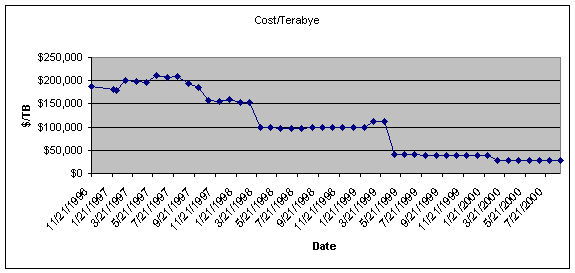
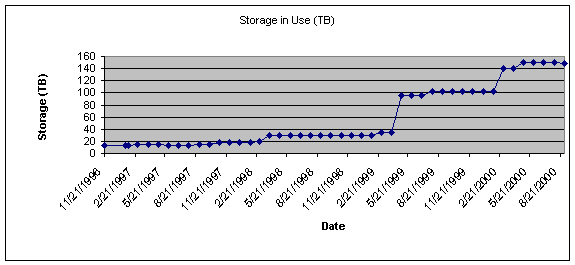
|
Contractor |
DOE Office |
|
Contract No.: DE-AC03-76SF00515 |
IMD Name: Walter Cyganowski |
|
Point of Contact:
William B. Johnson |
Telephone No.:
(510) 637-1737 |
|
Telephone No.:
(650) 926-2660 |
CO Name: Tyndal
Lindler |
|
FAX No.: (650)
926-5360 |
Telephone No.: (650) 926-4963(SLAC) |
|
E-mail: wbj@slac.stanford.edu |
(510) 637-1885 (OAK) |
Date of last assessment: October 1999
The Stanford Linear Accelerator Center (SLAC) is
dedicated to experimental and theoretical research in elementary particle
physics and in those fields that make use of its synchrotron radiation
facilities, including biology, chemistry, geology, material science and
electrical engineering. This includes the development of new techniques in
particle acceleration and detection, and of synchrotron radiation sources and
associated instrumentation. The Center is operated as a national user facility
for the Department of Energy by Stanford University.
The Computer Information Resource Management
functional area is responsible for coordinating Information Management
activities within the Laboratory. This coordination effort includes
encouragement of information standards to ensure broad availability of
information resources, of computer and systems procurements that have Laboratory
support, and are part of Laboratory wide information planning practices.
The Computer Information Resource Management
functional area self-assessment is based on, and measured against, performance
objectives and standards as reflected in the SLAC contract that were defined by
SLAC managers and DOE points of contact in order to address customer
satisfaction, cost efficiency, and contract compliance.
Names, titles, affiliations of participants
Bill
Johnson, IRM Computing Manager, BSD
Douglas
Kreitz, Assistant Director, BSD
Status of Open Items from 1999 Review
The BaBar program has been extremely productive during FY2000. Luminosity in PEP II has increased more rapidly than expected, reaching nearly 80% of design luminosity in August. By virtue of this luminosity, the BaBar detector has recorded more than 10 million B meson pairs, producing a flood of data that pressed the BaBar computing resources to the limit. In order to accommodate this plethora of data, SLAC Computing Services (SCS) and BaBar physicists have been expanding computing resources as rapidly as possible. Three different areas deserve special mention:
The
IBM RS/6000 AIX Farm has been phased out in favor of Sun Microsystems Batch
Workers. The BaBar Collaboration has made the decision that SLAC will provide
primary support for the Sun Microsystems components of computing for the
Collaboration while other Laboratories will provide support for other
architectures. At the
beginning of FY00 there were roughly 300 Sun Ultra 5 systems.
These were upgraded to Netra T1 systems and 600 new T1 systems were added
for a total of 900 Batch worker machines. These
are deployed in different ways depending on BaBar’s needs.
At present 150 are dedicated to “prompt reconstruction.”
These machines are an adjunct of the On-Line Data Acquisition system and
must be present before the BaBar Detector can collect data.
Another 150 machines are dedicated to BaBar reconstruction to process
BaBar events that have been recorded to tape.
Another 50 machines are dedicated to the BaBar Database Group for testing
purposes. The remainder of machines
(550 in number) are Batch Farm processors available to the Laboratory High
Energy Physics Program and are currently heavily used by BaBar but with some
usage by the End Station A Program and the GLAST Program.
These machines are actively used for Monte Carlo calculations and general
data analysis.
BaBar
(via SCS) is evaluating a Pilot Farm project deploying Intel processors running
Red Hat Linux. Presently 16 Dell
dual processor machines are attached to this farm.
This Intel Farm appears to be a cost effective way of supplying raw
computing power for the BaBar program.
Intel Commodity Computer Purchases
Virus
Detection
The InocuLAN anti-virus
product has completely replaced the McAfee product at SLAC and pervaded the
Windows culture at the Laboratory. In a year when computer users
everywhere have been assaulted by a continual barrage of viruses and worms, this
network-based virus detection package has been enormously effective in
protecting the Laboratory. InocuLAN has been extremely responsive in
supplying signature updates, sometimes several times per week. (More
details about virus activities at SLAC are given in the Unclassified Computer
Security Self-Assessment).
Computing
and Information Management Policies
Laboratory Policy
Committees, which had been in a formative state in FY99, have been fully
functional throughout the year. There are two committees responsible for
addressing computing policies
In the discussion below,
policies attributed to these committees are noted and discussed where
appropriate.
New
Items of Interest in 2000
Y2K
Status
Like most US
institutions and businesses, SLAC experienced no significant Y2K failures during
or after the transition to 2000. ADCC was actively involved in decisions
preparing for the transition and in reviewing transition events.
Intel
Systems Summary
Because
of the growing number of Linux security exploits, the SCS Security group has
strongly recommended that Linux administrators use the standard SCS installation
scripts when installing new Red Hat Linux systems.
When vulnerable systems are detected using the ISS scanning tool
available to us through the Stanford University site license, system owners are
contacted and guided by the SCS Security group to apply the appropriate patches.
The
secure BIS cluster requires 128 bit encrypted ICA clients and carefully
restricted accounts on the WTS server. This
cluster will disappear behind a firewall that allows only ICA protocols when the
Secure Business Services Project is completed.
Macintosh Support
Because of limited support
resources and lack of qualified candidates for support positions, SCS support
for Macintosh systems was discontinued during FY99 and users pointed to
available commercial resources when support is essential. This reduction
was not made on technical grounds but purely to provide adequate support at SLAC
for one PC platform (Windows NT). Because of Macintosh popularity at SLAC,
ADCC and CCC took a further step this year by requiring Associate Director
approval of all new Macintosh purchases.
Windows
2000 Support
Because
Active Directory Domains in Windows 2000 are such a departure from the NT 4
Domain concept, SLAC is taking precautions to limit the introduction of Windows
2000 into the community. This has
been accomplished by the following measures:
A
Windows 2000 (Win2K) Working Group has been established to propose a
suitable active domain structure for SLAC.
Windows
2000 machines must be registered to assure that Browser services, Dynamic
DNS services, and Active Domain components are disabled to avoid disruption
of the existing NT 4 Domains.
Installation
of registered Windows 2000 desktops has been discouraged until support
issues are fully understood. This
has been successfully achieved through cooperation with the NT Administrator
and Support Group at SLAC.
Installation
of Windows 2000 is allowed/encouraged on Laptops because plug-and-play
features greatly simplify support for laptops.
At the same time this provides experience for supporting Win 2K in
the NT 4 Domain environment.
A
test Active Domain, following Win2K Working Group design parameters, will be
established and offered to adventurous Domain Administrators.
SCS
has acquired and is deploying a set of Planning, Analysis, and Management
tools from FastLane that will aid in the transition to Win2K.
They are also closely following industry experience in making the
transition. We anticipate
beginning the transition during calendar 2001.
Two other important
policy issues have been addressed in conjunction with this transition: 1)
Computer replacement cycle and 2) staff training for System Administrators.
Because of the resource demands of Windows 2000 and SCS’s inability to support archaic operating systems, CCC recommended to ADCC that all departments adopt a 3.5 year replacement cycle for computing systems.
In
order for System Administrators to keep pace with new technologies, CCC also
recommended a training budget of $3000 for each NT Administrator.
Institutional
Data:
For
a number of years, the SLAC Institutional Data Committee (IDC) has been
identifying data resources that need to be integrated into a single
Institutional Data Structure at SLAC. Since
these data span all Divisions but have grown out of internal functional needs
within each department without central planning, the data is often duplicative
and, more seriously, lacks definitive ownership. Intra-divisional coordination
is very strongly required in order to correct this situation.
IDC
presented its findings at a CCC meeting and subsequently reported them to ADCC
with a recommendation to establish a “Data Czar” within the Directors Office
to achieve this coordination. A job
description for this post has been created and a preliminary search begun to
fill the position.
Performance
Side-Bar Indicators
STK
Silos
The
Silos remain an extremely effective mechanism for providing mass storage for the
Laboratory, even after more than a decade of evolution.
The history depicted in the two charts below amply show the versatility
and cost effectiveness of this medium. During
the past year the cost per Terabyte of storage space has dropped by 30% while
the volume of storage in use has increased by 50%.
A further sign of system flexibility is the ease with which this mass
storage media has been integrated in the managed storage system HPSS, giving the
Laboratory a seamless repository for all its data.


World
Wide Web Usage
The
SLAC Web also has grown in sophistication and functionality through the use of
virtual Web technology. New Web
analysis tools have been purchased and deployed during FY00.
The charts below were generated using these tools.
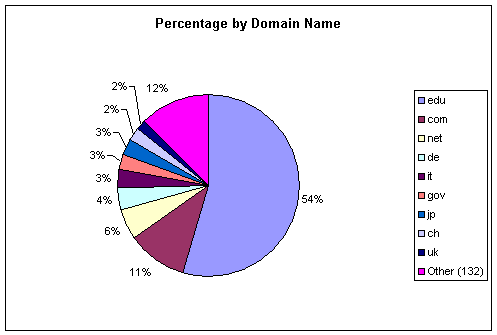
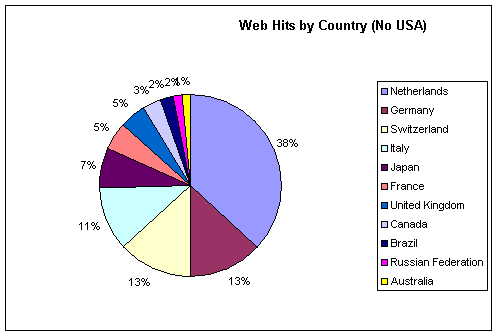
The first two charts
show the majority presence of educational institutions in the SLAC Web traffic
patterns. The .COM and .NET traffic for the most part are the inevitable
Web search engines that perpetually index the data at all Internet Web sites.
In the “Hits by Country” plot we see evidence of our international
collaborators and a surprisingly large (and presently inexplicable) presence of
hits from the Netherlands.
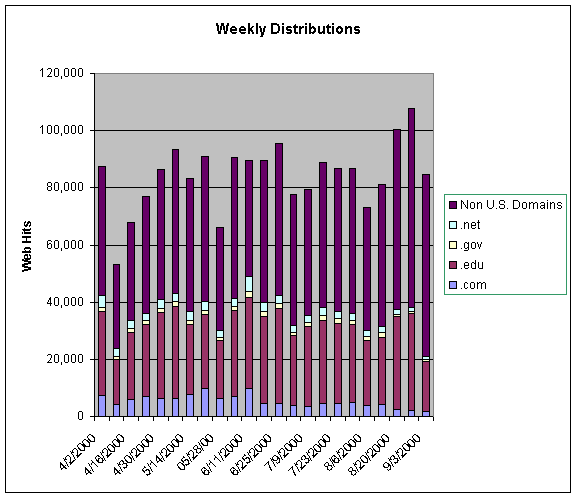
The third chart shows
weekly distribution of hits, indicating that approximately half the traffic is
from non-U.S. Domains above a fairly constant pedestal of .EDU and .COM traffic.
The
final chart shows the client Operating System composition of SLAC’s Web
traffic. Not surprisingly this has
a dominant Windows NT component since much of the traffic is internal to SLAC
where Windows NT is the dominant system. Linux
also has a very strong presence, reflecting the trend toward Linux in the High
Energy Physics community worldwide. The
Macintosh component, once strong at SLAC and HEP in general, has fallen to 4%.
This may reflect SLAC’s (reluctant) reduced support policies for the
platform.
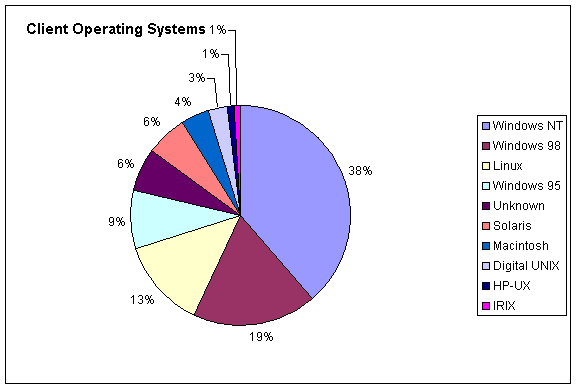
Compute Farms
As in FY99, SLAC Compute Farms have undergone rapid, continuing growth and
change. Indicators to track this change numerically cannot be meaningfully
defined at this time because of the pace of change. From the point of view
of satisfying the needs of the scientific community, however, great progress has
been made to supply an immense and flexible computing resource. At the
beginning of the year there were 300 Sun Ultra 5 systems in the Farm operating
at 333MHz; at the close of FY00 there are 900 Sun Textra 1 systems operating at
440MHz with a resulting 400% increase in computing capacity. In less
than a decade, there has been an increase of more than two orders of magnitude
in available computing power for physics at SLAC. Furthermore, the present
farm is dramatically more flexible in its ability to dedicate portions of the
farm to a particular activity. In the case of BaBar, the principal user of
the Farm resource, 150 processors are dedicated to prompt reconstruction during
the BaBar data taking cycle in order to provide monitoring statistics for the
detector while data is being accumulated.
In addition to
the Sun farm, two Intel Compute Farms are in operation:
one for Accelerator Research (ERDA) consisting of 16 Dell processors
running Linux; the other is a BaBar pilot project, recently upgraded to 34 Dell
processors running Linux. These
Intel Farms show great promise for providing highly cost effective mass
computing resources.
This goal was fully
accomplished, as indicated above through the establishment of
No significant progress
has been made in this area. With the Peer Review process imminent in the
future, it was impractical to establish SCS based measures until the
requirements for Peer Review are fully known.
Goals for FY 2001